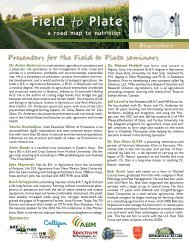organic matter, humus, humate, humic acid, fulvic acid, and humin
organic matter, humus, humate, humic acid, fulvic acid, and humin
organic matter, humus, humate, humic acid, fulvic acid, and humin
You also want an ePaper? Increase the reach of your titles
YUMPU automatically turns print PDFs into web optimized ePapers that Google loves.
protection from inferior products. There are many “<strong>humic</strong> <strong>acid</strong> type” products currently marketed in he United States.<br />
Some of these “<strong>humic</strong>” products have been developed by industrial chemists, industrial concerns have made many attempts<br />
to manufacture <strong>humic</strong> <strong>acid</strong>s using different industrial processes. As a result several “synthetics” have been produced,<br />
marketed, purchased, <strong>and</strong> used. Most of these synthetics have been polymers of vinyl acetate, maleic <strong>acid</strong>, polyvinyl<br />
alcohol, hydrolyzed polyacrylonitrile, carboxymethylcellulose, polyacrilates, isopropyl acrylamide <strong>and</strong> poly-quaternary<br />
ammonium compounds. Generally these synthetic <strong>humic</strong> molecules have performed poorly in terms of their ability to<br />
improve soil fertility or plant growth. These products should not be defined as <strong>humate</strong> based fertilizer ingredients since<br />
their performance under field conditions are very erratic. A chemical analysis of their molecular features reveals that these<br />
“synthetics” lack many of the properties of naturally occurring <strong>humic</strong> substances. They lack the molecular features which<br />
improve soil fertility <strong>and</strong> are frequently incompatible with plant metabolic processes. Other industrial groups have obtained<br />
from mature, alkali-insoluble lignite-like coals, treated these materials with degradative <strong>and</strong> oxidation processes to produce<br />
smaller alkali soluble “<strong>humic</strong>” solutions. The resulting oxidized mixtures from black coals or lignite coals are termed<br />
“regenerated <strong>humic</strong> <strong>acid</strong>s” or “ulmins”. These “ulmins” have characteristics which are similar to <strong>humic</strong> <strong>acid</strong>s derived from<br />
low grade lignites, however are quite different chemically, thus the term “regenerated” is a misnomer. There is no evidence<br />
that these “ulmins” have desirable fertilizer grade properties. Hopefully members of the International Humic Substances<br />
Society can propose quality st<strong>and</strong>ards (labeling) for all commercially marketed <strong>humic</strong> substances <strong>and</strong> develop laboratory<br />
procedures capable of monitoring the quality of listed ingredients. Until st<strong>and</strong>ards can be designed, which are acceptable to<br />
the industry, growers <strong>and</strong> gardeners should purchase <strong>humate</strong> based (dry <strong>and</strong> liquid) products that have been extracted from<br />
highly oxidized mined low grade lignites or leonardites. Humic substances from such mineral deposits more closely<br />
resemble <strong>humic</strong> substances normally found in fertile soils <strong>and</strong> in healthy plants.<br />
Application of <strong>humate</strong> based dry or liquid fertilizers can improve product quality <strong>and</strong> increase production. As outlined<br />
above <strong>humic</strong> substances are the building blocks of fertile soils <strong>and</strong> healthy plants. One important reason for adding <strong>humate</strong><br />
based fertilizers to the soil is that the producer can again become a steward of the soil. By developing a more ecologically<br />
sound agricultural productions system it is possible to reduce soil, water, <strong>and</strong> air pollution. In addition, crop yields will<br />
improve <strong>and</strong> the nutritional value of the harvested products will significantly improve in quality. The extent to which<br />
<strong>humate</strong> based fertilizers improve crop yields depends on the history of cropping practices used on each field. Soils severely<br />
damaged by excessive use of <strong>acid</strong>ic fertilizers or pesticides generally respond slowly the first year. Generally the first<br />
improvements observed are in product quality. As toxic soil conditions are remediated (corrected) <strong>and</strong> additional <strong>humate</strong>based<br />
fertilizers are applied, crop yields <strong>and</strong> product quality continue to improve.<br />
A word of caution. Avoid applying excess fertilizers (of any type) to soils or plant surfaces. Individuals who apply<br />
fertilizers to soils (e.g. producers, farmers, <strong>and</strong> gardeners) should keep in mind that excessive applications of any fertilizer<br />
can create imbalances <strong>and</strong> even reduce soil fertility. The positive impact of <strong>humic</strong> substances on plant growth can be<br />
reversed by applying excessively high concentrations of these fertilizers. Follow recommendations that have been based on<br />
many years of experience.



